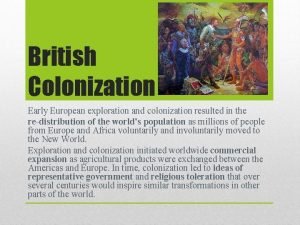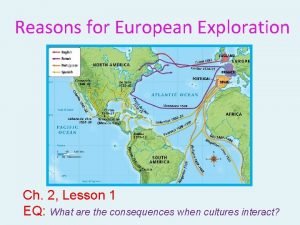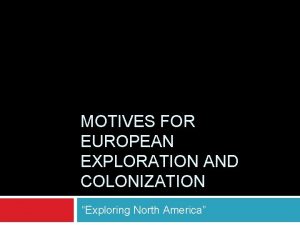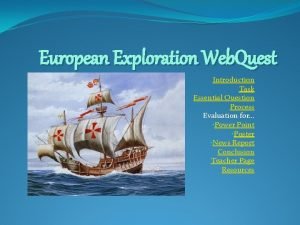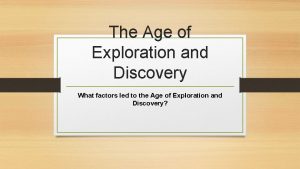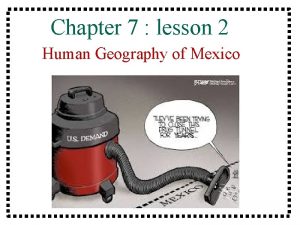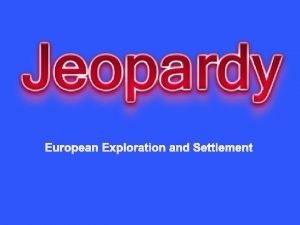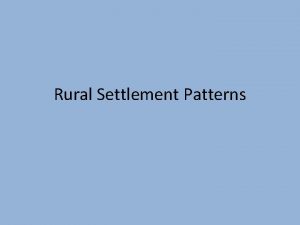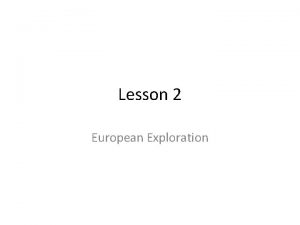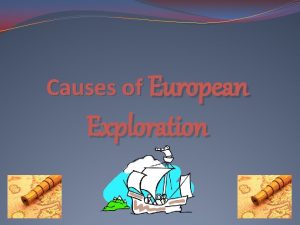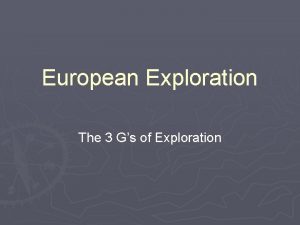GEOGRAPHIC FACTORS INFLUENCED EUROPEAN EXPLORATION AND SETTLEMENT IN











- Slides: 11

GEOGRAPHIC FACTORS INFLUENCED EUROPEAN EXPLORATION AND SETTLEMENT IN NORTH AND SOUTH AMERICA Level 2

VOCABULARY • Mother Country: a country that created a colony • Colony: a group of people who leave their mother country to start a new settlement but are still under the rule of the mother country • Explorer: someone who investigates a new area • NW Passage: a sea route connecting Europe to Asia by connecting the Atlantic Ocean to the Pacific Ocean • Mayflower Compact: made by the Pilgrims as an agreement of government • Missionary: a person sent by a church to spread the faith of the church

ESSENTIAL QUESTIONS • How did weather and natural hazards affect the explorers? • What are the similarities between settlement locations? • What are the similarities and differences between “New England”, “New France”, “New Netherland”, and “New Spain”?

EFFECTS OF WEATHER AND NATURAL HAZARDS ON THE ATLANTIC CROSSINGS • Diseases on ships like scurvy led to a high death rate • Lack of food and clean water led to disease and malnutrition • Atlantic Ocean is more violent than the Mediterranean Sea that the explorers were more used to sailing which led to the sinking of ships • Making port proved difficult because of the lack of knowledge of the sea floor and led the ships to be damaged • Ships leaked in water and some sank • Weather such as hurricanes and tropical storms destroyed or damaged ships

• Short winters • Fertile soil • Settled near waterways • Mountains, island coastal plain • Natural Resources: fish, timber, beaver New Spain • Settled near waterways • Temperate to arctic climate short growing season • Natural resources: beaver, fish, trees • Mostly Plains New Netherland • Hills with rocky soil • Natural resources: fish, whales, trees, furs • Cold climate short growling season • Settled next to waterways New France New England CHARACTERISTICS OF PHYSICAL ENVIRONMENTS WHERE DIFFERENT EUROPEANS SETTLED • Tropical to desert climate • High, rugged mountains, low coastal plains, high plateaus, desert, islands • Settled near waterways

THE DEVELOPMENT OF “NEW ENGLAND” • Massachusetts: – Original purpose: Religious Freedom for the Puritans – Pilgrims on the Mayflower • Navigation mistake sent them to Plymouth Massachusetts instead of Virginia – Signed the Mayflower Compact – Education was important in order to read the bible • • • Grammar schools were built Harvard was build in 1636 Rhode Island: – Roger Williams, kicked out of Massachusetts Bay, started Rhode Island – Wanted separation of church and state and religious freedom • • Connecticut: settled by Massachusetts Bay and Plymouth colonists in the 1630’s who wanted a more liberal and a more strict view of religion New Hampshire: was settled but didn’t have a royal charter until 1679 Economy: fishing, ship building and fur trading English Colonies

THE DEVELOPMENT OF “NEW FRANCE” Exploration of Cartier Exploration of Champlain

THE DEVELOPMENT OF “NEW FRANCE” • Why did the explorers come? – The King of France wanted them to find a trade route to Asia as well as gold and gems • Who came to New France to colonize? – Soldiers : came to build forts and protect against the Iroquois and then stayed – Catholics: • • Jesuits: Roman Catholic priests who set up schools for boys and converted Natives to Catholicism Ursuline Nuns: started schools for girls and helped convert the Natives – Fur Traders: The Company of 100 Associates controlled New France and the fur trade with the Natives until the King took over direct control of both the government and the fur trade – Farmers: owners of land granted to them by the King and those who worked and lived on the land (similar to sharecroppers) – Filles du Rois: mostly orphan girls were sent to encourage marriage for the large male population – Slaves: mostly Natives but also Africans • Territory: Eventually stretched to what is now Canada to New Orleans, Louisiana

THE DEVELOPMENT OF “NEW NETHERLAND” • Why did they come? – Dutch East India Company hired Englishman Hudson to explore to find the NW Passage to Asia; Hudson sailed up the Hudson River to Albany and claimed the area for the Dutch East India Co. • Who came? – Dutch West India Co. was founded and sent 30 families to what is now Manhattan to settle there and New Amsterdam was created (now NYC) • Economy: – Focused on the fur trade but eventually moved to food, timber, tobacco and the slave trade after the Dutch West India Co. gave up its claim to the area • Taken over by the English

THE DEVELOPMENT OF “NEW SPAIN” • Why did Spain come? – Gold, silver, convert Natives to Catholicism, land • Who came? – Families, adventurers and Catholic missionaries • Explorers: – – – De Soto De Leon Coronado Balboa Pizarro Cortez • Economy: sugar plantations and mining, farming, ranching • Colonized to protect their land claims

ESSENTIAL QUESTIONS • How did weather and natural hazards affect the explorers? • What are the similarities between settlement locations? • What are the similarities and differences between “New England”, “New France”, “New Netherland”, and “New Spain”?
 Factors for european exploration
Factors for european exploration Exploration cloze notes 1
Exploration cloze notes 1 Early european exploration and colonization resulted in -
Early european exploration and colonization resulted in - European exploration map
European exploration map Roanoke island mystery
Roanoke island mystery 4 g's of exploration
4 g's of exploration Gold god glory drawing
Gold god glory drawing Age of exploration webquest
Age of exploration webquest European exploration economic reasons
European exploration economic reasons What factors led to the age of exploration
What factors led to the age of exploration Chapter 7 lesson 2 human geography of mexico
Chapter 7 lesson 2 human geography of mexico Is a wooden chair biotic or abiotic
Is a wooden chair biotic or abiotic


